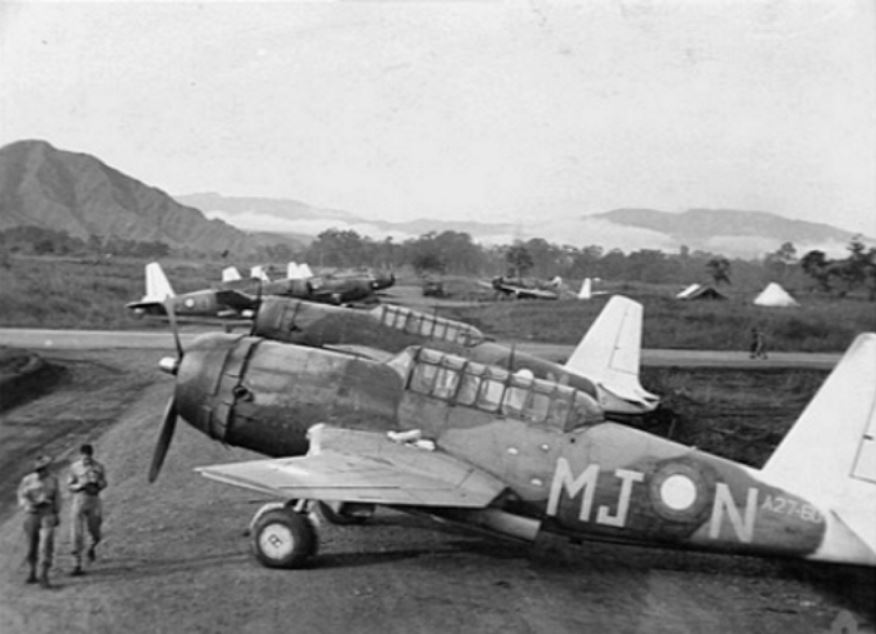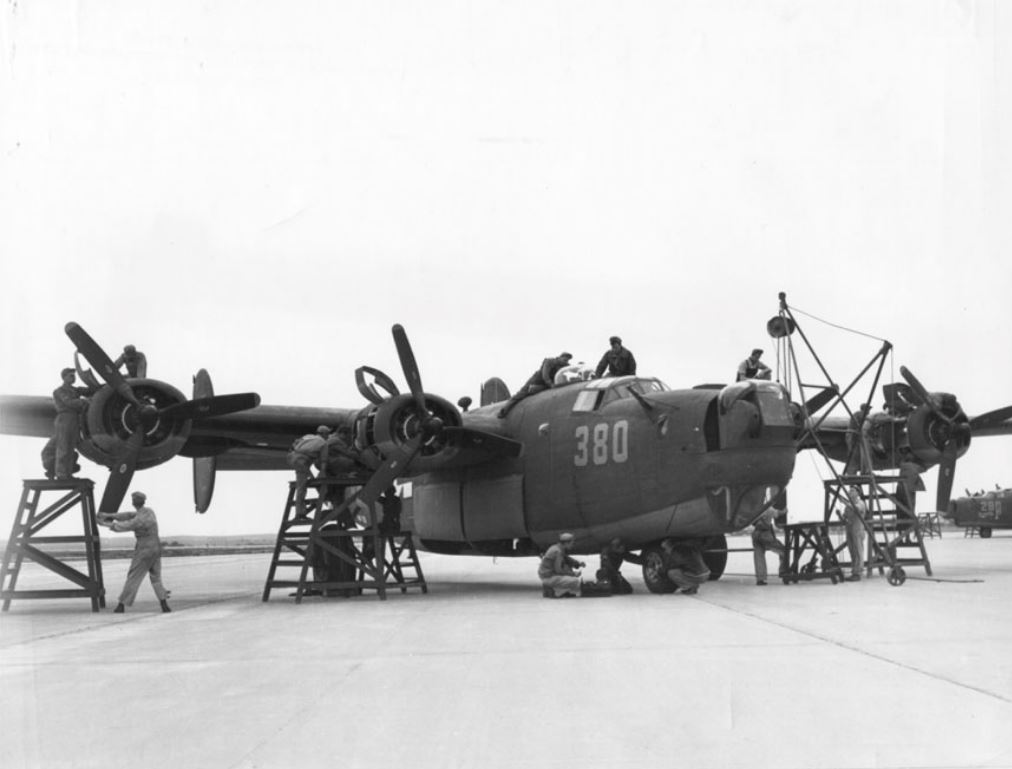No. 21 Squadron RAAF
From Our Contribution
 Vultee Vengeance dive bomber aircraft of No. 21 Squadron RAAF, Nadzab airdrome, | |
 Consolidated B-24 Liberator bomber | |
Contents
[hide]Brief History
The squadron was equipped with a variety of aircraft during the war. Their role changed with aircraft type, working as a fighter unit in the Malayan campaign, as a dive bomber unit in the New Guinea campaign, and as a heavy bomber unit over Borneo.
With the outbreak of World War II, the squadron was mobilised and its personnel placed on full-time service. The level of training increased as the squadron was brought up to strength and prepared for its first operational missions. Their first mission came on 15 December when aircraft were assigned to convoy escort duty.
The squadron undertook similar missions in the Great Australian Bight, providing protection for ships sailing for Europe. Initially, the squadron operated Hawker Demons, Avro Ansons, Avro Cadets and a North American NA-16 (Harvard). Soon afterwards it was re-equipped with the Australian-built CAC Wirraway and switched to an army co-operation role.
In August 1940, the squadron was dispatched to Seletar, on Singapore, where it operated its Wirraways in support of ground forces that had been stationed there as the threat posed by Japan escalated. In early 1941, No. 21 Squadron was re-designated a fighter unit and was sent to Sembawang to re-equip with the Brewster Buffalo - probably the worst fighter aircraft ever to have been operated by the RAAF. In mid-1941, as the situation with Japan deteriorated, the squadron was sent to Sungai Petani on the Malay Peninsula where they augmented four other British Commonwealth Squadrons, including No. 453 Squadron RAAF.
Buffalos that participated in the Malayan campaign were beset with numerous problems. Issues included poorly built and ill-equipped planes, inadequate supplies of spare parts, inadequate numbers of support staff, airfields that were difficult to defend against air attack, antagonism between RAF and RAAF squadrons and personnel, and inexperienced pilots lacking appropriate training who were soon to be pitted against combat experienced Japanese pilots flying the most lethal fighter in the Pacific theatre- the Mitsubishi Zero.
The squadron's first involvement in the fighting came on 8 December 1941, following a heavy Japanese bombing raid on Sungai Petani, which resulted in the loss or damage of several of its aircraft. Initial interception operations proved unsuccessful and, as a result of heavy damage to the airfield, the squadron was withdrawn to Ipoh, falling back through Butterworth, where the squadron achieved its first air-to-air victory, when a Buffalo shot down a Mitsubishi A6M Zero fighter. No. 21 Squadron suffered severe losses to Japanese fighters, on the ground and in the air, during the first week of the campaign. Replacements were limited, resulting in the squadron needing to merger with 453 Squadron.
Together the merged squadron continued operations, but they were withdrawn again, this time back to Singapore.
Operating once more out of Sembawang, 21/453 Squadron, as it became known, flew convoy escort, reconnaissance, air defence and bomber escort missions. On 16 January, while escorting a flight of Vickers Vildebeest light bombers, six of the squadron's Buffaloes shot down three Japanese fighters that rose to attack the Vildebeests. Later, on 26 January, two more Japanese fighters were destroyed and another possibly shot down during a bomber escort mission over Endau. Following the Endau mission, 21 Squadron it had its remaining aircraft taken away and it was split from No. 453 Squadron, with surviving pilots and ground crew sent to Java via Sumatra in the Dutch East Indies where they undertook ground support duties before being evacuated to Australia. The squadron was disbanded in Fremantle in March 1942.
In September 1943, No. 21 Squadron was re-formed at Gawler, South Australia, and equipped with US made single engined Vultee Vengeance dive-bombers. Following a period at Lowood, Queensland, for advanced training, the squadron transferred to Nadzab in New Guinea in January 1944. By the end of February the unit had carried out attacks on Japanese barge hide-outs on the Wagol River. Supply dumps and enemy troop concentrations were also attacked and the squadron took part in large air raids on the Japanese airstrips at Hansa Bay, Madang and Alexishafen in concert with Nos. 23 and 24 Squadrons.
Following further attacks in March against Japanese camps around Pommern Bay and Rempi village, the Vengeance was withdrawn from front-line operational service in New Guinea, as Allied commanders deemed its short flying range unsuitable for the conditions. As a result, No. 21 Squadron returned to Australia on 13 March 1944.
Moving to Camden, New South Wales, and then Leyburn, Queensland, the squadron converted to Consolidated B-24 Liberator heavy bombers in June 1944. Conversion training took six months and as a result, the unit did not see operational service again until 11 January 1945, when, as part of No. 82 Wing RAAF, it attacked targets at Laga and a radio station at Moena Island, operating out of Fenton in the Northern Territory.
During January and February 1945 more than a hundred missions were flown against Japanese targets. On 6 April, near Koepang, the squadron participated in an unsuccessful attack on a convoy of ships, including the cruiser Isuzu. Other targets attacked included troop areas at Tawo and fuel tanks in Tarakan and Borneo. From July, while the main force remained at Fenton, the squadron sent a detachment to Morotai Island. In the final months of the war the squadron's last operations were in support of the Allied landings at Labuan and Balikpapan.
With the war's end, the unit's aircraft were utilised as shipping escorts and as transports before they returned to Tocumwal, New South Wales. During the war, 42 men from the squadron were killed in action or died on active service.
Battle Honours
- Malaya 1941-42
- New Guinea 1944
- Markham Valley 1944
- Morotai 1945
- Borneo 1945
Individual Honours
- 5 Distinguished Flying Crosses
- 1 Mention in Despatches.
Air Crew
- Alfred Arthur Shepherd 18 Oct 1944 - 1 Apr 1945
- Henry Frederick Wills 7 Nov 1945 - 8 May 1946
Ground Crew
- Avon William Mills 13 Sep 1943 - 6 Jun 1945
- Vernon Wallace Marsh Nov 1944 - Feb 1946
Notes
Content for the history and honours sections has come from a combination of Wikipedia, the Australian War Memorial website, and more particularly the Virtual War Memorial Australia site page compiled by Steve Larkins in January 2018.